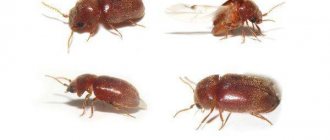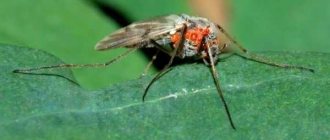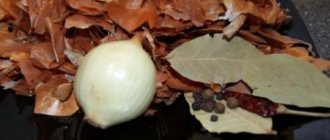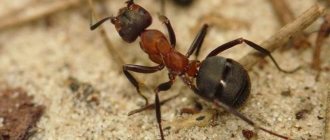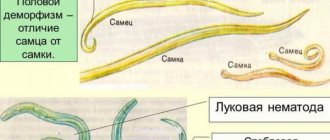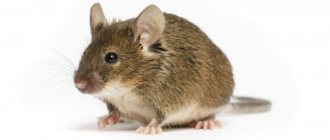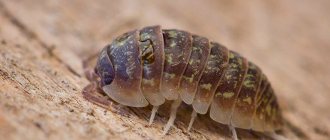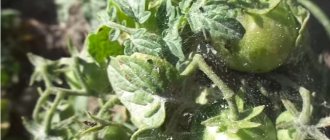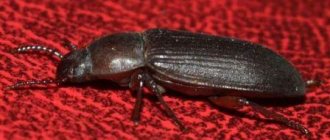The flour mite is a tiny creature that, despite its small size, forces you to throw away all infected supplies. This arachnid, being a very common type of barn pest, can cause significant economic damage. Today we will consider in detail its harmfulness, as well as the main methods of control and prevention.
general description
This is a barely noticeable bug, the size of which does not exceed one millimeter. It can only be seen thanks to the colors. It has reddish-brown legs and a dull white or light gray body with four stripes on its abdomen. Despite the lack of organs of vision, he is quite mobile.
The main feature of the flour mite is that it is able to move not only on horizontal, but also on vertical surfaces. This insect lives relatively short. But in a very short time, females can lay several hundred eggs. In addition, this pest easily adapts to any living conditions and tolerates sudden temperature fluctuations. Scientists have found that these insects survive even after treatment with radioactive radiation.
Habitat of the flour mite
This insect can often be seen in warehouses, barns, bakeries, sheds and fields. It occurs in food processing plants, kitchens, grocery stores and livestock pens. It lives in the remains of plant food, rotting wood, haystacks and rodent burrows.
In general, this pest lives where various types of food are stored, including dried fruits, nuts, flour and cereals. If a colony of such mites develops indoors, it can capture not only food products, but also medicines or tobacco products stored there. A favorable environment for their life is the uncollected remains of straw and fodder.
Rodent control.
- Preventive action. Construction of premises impenetrable to rats and mice, for which concrete floors are made, broken glass is poured under the floor; continuous sheets of iron are laid under the floor and partially in the walls. If it is impossible to isolate the entire warehouse, then at least the products must be isolated.
- a) the use of toxic substances - white arsenic, arsenous anhydride, barium carbonate, phosphorus, strychnine, burnt gypsum, zinc, etc. Toxic substances are mixed with bait and scattered near the holes;
Features of reproduction
Like most arthropods, these mites require special conditions. They can only reproduce if there is enough organic matter and no direct sunlight. The optimal conditions for the continuation of the species of these pests are considered to be a temperature of 18 to 27 degrees and humidity within 15-18%.
The females of this insect are capable of laying several hundred eggs during their short life. At the end of the incubation period, a tick larva emerges from each of them. It has three pairs of limbs, and its size is so small that it can be compared to a poppy seed. Before turning into an adult, it feeds intensively and goes through two molts. There are no bristles or membranes on her body.
After a few days, the tick larva transforms into a first-generation nymph, whose lifespan is only a week. During this time, it manages to increase significantly in size, acquire an additional pair of limbs and become similar to an adult insect. Under favorable conditions, after the next molt, she turns into a second instar nymph. After a few days, it becomes an adult insect capable of reproducing offspring. The entire development cycle lasts two weeks.
Book louse
External structure: This insect does not exceed 1 mm in length. The body is flattened, with the abdomen rounded at the apex. The color is white-brown or with a predominance of white shades. There are long antennae on the head. An adult insect has 3 pairs of legs. The femora of the posterior pair are noticeably thickened and have an almost triangular shape.
Lifestyle: In order to reproduce, these insects do not need to look for partners for mating. In the body of each individual, the maturation of eggs occurs spontaneously, and each louse can lay up to 100 eggs on the product. They leave one or several eggs at a time on hard surfaces, covering the clutch with rectal secretions on top. The hatched larvae immediately begin to feed, accumulating strength for transformation. Before becoming an adult, each of them will be forced to shed the shell that has become tight 6 times.
Book lice are unpretentious and develop successfully at temperatures from 16 to 35 oC. Under favorable conditions, the species can reproduce continuously throughout the year, giving up to 6 generations.
Prevalence: Throughout the Russian Federation.
Harm: Book lice feast on any starchy substances that begin to mold or even rot. They are frequent guests at processing plants and granaries. These pests eat away the germs of grains, reducing the germination of seeds and their nutritional characteristics. They clog the products with numerous larval shells and excrement, promoting even greater development of mold processes. Book lice most often settle in places where grain products become damp or stale. They cause the greatest harm in warehouses with poor air exchange.
Microscopic mites and lice, having settled in a warehouse, can cause significant damage to stored grain and flour reserves. The most valuable parts of the grains suffer from them. They pose the greatest danger to grain germs. At first, they are almost impossible to notice, and they covertly affect products, clogging them with toxic substances, spreading mold and bacteria hazardous to health. When humidity increases and in those rooms where the ventilation process is not well organized, they cause the greatest damage to goods.
To reduce the risk of infection, before accepting cargo, premises must be thoroughly cleaned of broken grains, husks and other residues where ticks and lice find refuge. However, it is possible to completely get rid of their presence only through quarantine phytosanitary disinfection. The First Fumigation Company will always help you carry out such treatment. We have the most effective drugs in our arsenal. The professional equipment we use will ensure uniform distribution of substances in the room and the destruction of all pests.
How dangerous is this insect?
The flour mite causes great harm. It spoils the grain and reduces the germination of the crop. Destroying agricultural crops, it leaves behind waste containing E. coli and other pathogenic microorganisms. It feeds not only on grain crops, but also on flax seeds, sunflowers, corn, crushed cereals, flour, dried fruits and meat waste.
An infected product becomes unfit for consumption. It can cause poisoning, scabies, Lyme disease and allergic reactions. By consuming such products, a person runs the risk of contracting hives and experiencing problems with the genitourinary or respiratory systems. Animals that eat such food may experience severe diarrhea and loss of appetite.
Habitat and diet
The flour mite is perfectly adapted to life in various conditions. It can easily tolerate extremely low or high temperatures. The same applies to laid eggs, which do not die at temperatures ranging from -5 to +60 degrees Celsius.
The grain mite can settle in the following places:
- warehouses where grain crops are stored;
- accumulations of straw;
- haystacks;
- livestock habitats;
- bakeries and other places where flour is stored;
- burrows of rodents and other small animals;
- plant remains (accumulation of autumn leaves, waste from wheat and other crops);
- cereal and corn fields;
- grocery stores;
- kitchens in private or multi-storey buildings.
The diet of mealy mites depends on the habitat. Larvae and adults can eat much more than their body weight and therefore cause serious damage to agriculture.
They eat the following foods:
- wheat and corn flour;
- flax seeds;
- rice, wheat and other cereals;
- various fruits;
- ground cereal;
- meat;
- compound feed;
- homemade baking;
- smoked meats;
- legumes;
- dried fruits;
- vegetables;
- carrion;
- tobacco;
- conservation.
How can you tell if there are insects in your food?
Most often, the pest mite begins to live in flour. Sometimes people simply cannot see such an insect. But its presence can be determined by a number of characteristic signs.
These mites have a rather specific smell, vaguely reminiscent of mint. If food supplies have such an aroma, it means that this pest has settled inside it. In addition, food infected with mites acquires a slightly sweetish taste.
Cereals and flour products infected with this parasite change color. A crust appears on their surface, resembling ordinary sand in appearance. There is another effective way to check flour for pests. To do this, pour it onto the table, level it and leave it for twenty minutes. If after this time tubercles appear on its surface, it means there is a tick in it.
You can also detect the presence of a parasite using double-sided tape. To do this, it is glued to any cabinet in which dried fruits, legumes, cereals or flour are stored. After a couple of days, you need to take a magnifying glass and carefully look at what is stuck to the tape.
How to get rid of a pest?
Since this insect not only destroys food, but also carries dangerous diseases, it must be combated. To get rid of the mite, you need to fumigate the grain. This method of destroying parasites is based on the use of gas mixtures that are destructive to microorganisms. Such canisters with toxic substances are widely used in agriculture and industry.
Contact insecticides, as well as chemicals based on sulfur and hydrogen phosphorous, have proven themselves well. However, they are not advisable to use at home. They are usually used to disinfect large batches of grain. At home, you can limit yourself to freezing or calcination.
Another radical measure to combat ticks is to throw away contaminated products. Immediately after this, the places in which they were stored must be disinfected. No less effective are methods based on creating conditions unfavorable for the existence of these pests. They cannot tolerate cold and low humidity.
How to protect granaries?
In large areas, you can fight the invader using chemical or mechanical methods and maintain a consistently clean condition of the barns through prevention. Chemical control measures are:
- preparations containing hydrogen phosphorous;
- contact insecticides;
- preparations with sulfur.
More often in large rooms they use Phostoksin, Detia-EX-V, Fostek. Infected grain is sprayed or treated with gas. The choice of option depends on the level of damage, volume of production, and area of the premises.
Naturally, such chemicals and gases are not used at home, since they are extremely dangerous and are designed for multi-ton batches of grain.
A safer way to protect grain from flour mites is by cooling, heating and mechanical cleaning. The grain should be cooled to a level from 0 to minus 5 degrees, accompanying the process with constant stirring. Organized drafts will also help. The grain should be heated (calcined) to a temperature of plus 55 degrees and above. At the same time, the grain masses also need to be stirred.
Constant mechanical cleaning of barns and warehouses will help reduce and prevent infection:
- grain transportation containers must be kept perfectly clean;
- Before filling the grain, the barns should be treated with lime, dried, and ventilated;
- there should be no garbage, scattered grain, flour, etc. in the barns, all this must be immediately collected and burned;
- When storing grain raw materials, the premises must be constantly ventilated;
- near flour mills, barns, warehouses, the areas should be crystal clean, without garbage, trash, dry leaves, grass, branches;
- Rats, mice, and birds should not enter storage rooms.
In barns, the required microclimate, temperature, and humidity must be maintained.
Useful tips
For tick control to be effective, it is necessary to prevent the presence of rodents near places where food supplies are stored. Repeated washing and using a strong chlorine solution followed by ventilation of the room gives a good effect.
At home, repellents such as lavender, garlic and bay leaves can be used to preserve food. And in order to get rid of these pests forever, it is necessary to find the main source of their spread and destroy it. Moreover, not only those products in which the parasite has appeared are subject to disposal, but also those that were simply lying nearby.
Danger to humans and animals
Mealy mites cause many difficulties for workers in the agricultural industry. It eats not only the grown grain, but also young shoots that could produce a new harvest. Affected seeds are difficult to distinguish from good ones, which leads to a significant reduction in yield.
Neighborhood with these pests poses a great danger to domestic animals and humans. This is due to the fact that tick waste products contain many harmful microorganisms, including E. coli.
When a contaminated product enters the body, tick-borne anaphylaxis begins to develop (a severe allergic reaction that can be fatal). It appears within a few minutes after eating.
Main symptoms of the disease:
- severe shortness of breath;
- wet cough;
- anaphylactic shock;
- problems with the digestive and genitourinary systems;
- allergic rashes accompanied by severe itching.
If one or more of these symptoms suddenly appears, you should seek help from a doctor as quickly as possible. They will help determine the cause of the problem and find ways to get rid of it.
Prevention methods
To prevent flour mites from infesting kitchen cabinets, they need to be cleaned regularly. It is advisable to constantly wipe all surfaces from crumbs and dust. Jars used for storing cereals must be dry, clean and hermetically sealed. It is recommended to place them in cool places, away from heat sources. In addition, you cannot bring home cereals or flour of questionable quality, purchased at a big discount. Very often, expired and low-quality goods that already contain pest larvae are sold at reduced prices. Therefore, by saving a couple of rubles, you can buy yourself a real problem.
You should not store large supplies of food at home. Buy as much flour and cereal as you can use in two weeks. Pet food is more susceptible to mite infestation. Therefore, it must be kept separate from other food supplies.
It is strictly forbidden to mix fresh and expired products. A prerequisite for preventing flour mites is maintaining an appropriate microclimate. The premises should be fresh, clean and not too hot.
Preventive actions
The best method to prevent flour mite contamination of stocks is, of course, prevention.
- Always check the integrity of bags and other containers in which food products are sold.
- Never purchase products that appear wet.
- An airtight package with a tight-fitting lid will prevent contamination of all food in the pantry if a mite does appear.
- Regularly check and clean the storage area.
- Try to sort and use foods as they come in - always use old ones first before opening new ones.
- Kitchen cabinets and cabinets should be dry and clean.
The above-described measures to combat flour mites and proper prevention will ensure that the pest will never be allowed into your home again.
